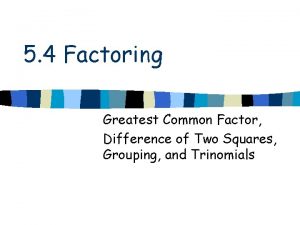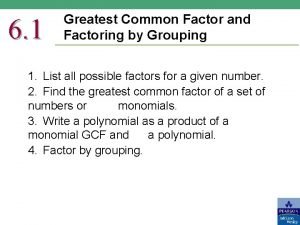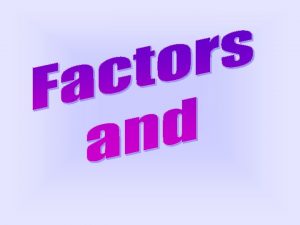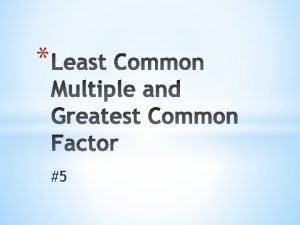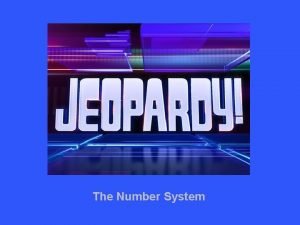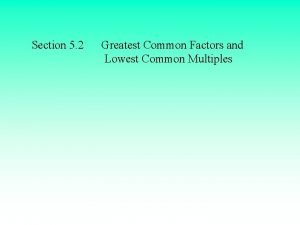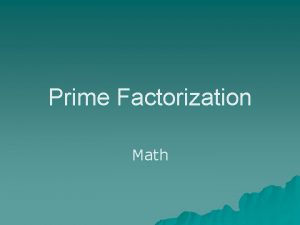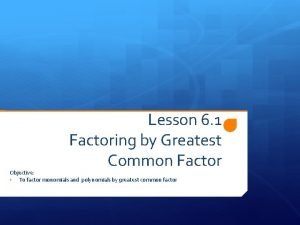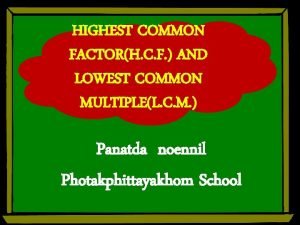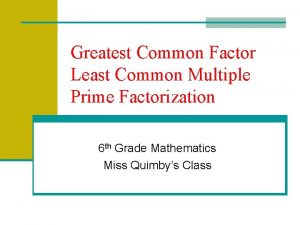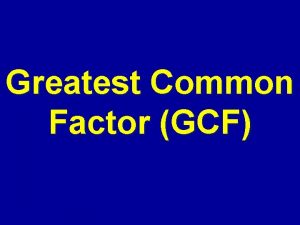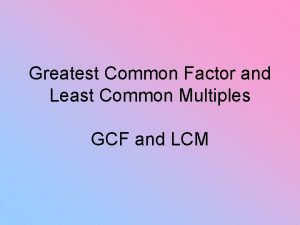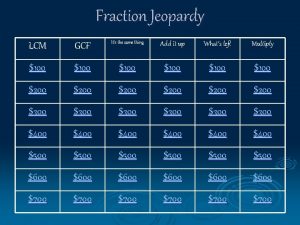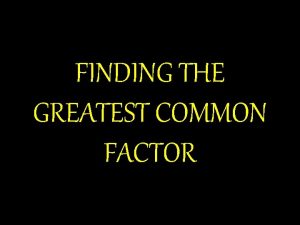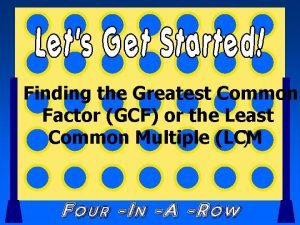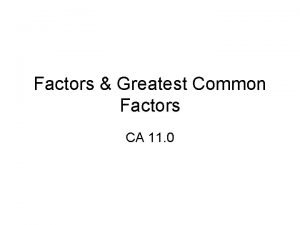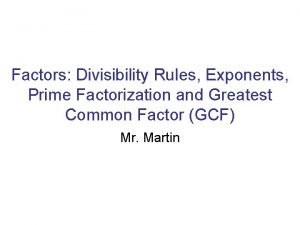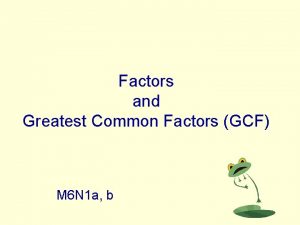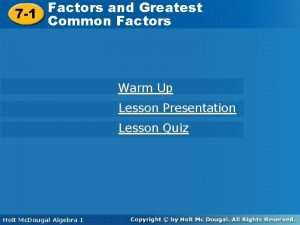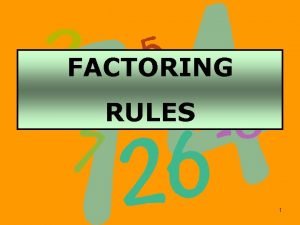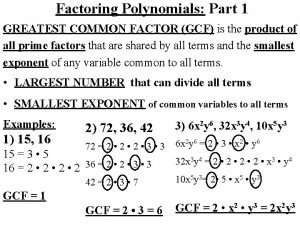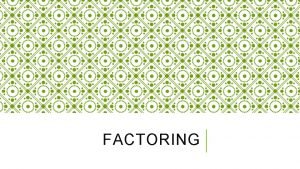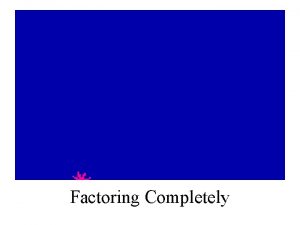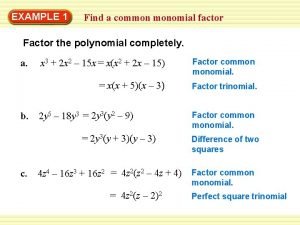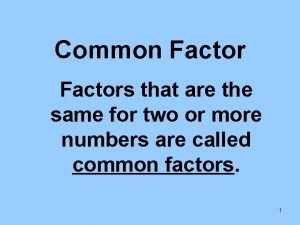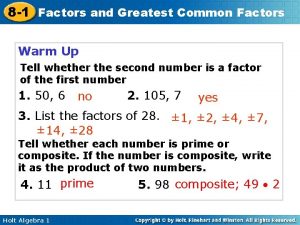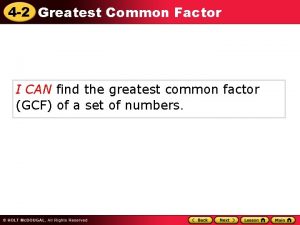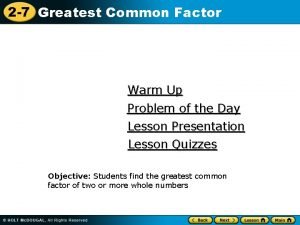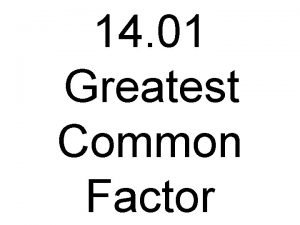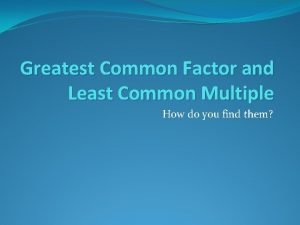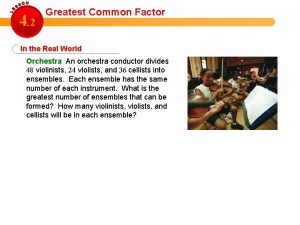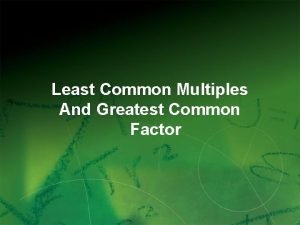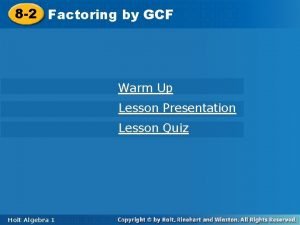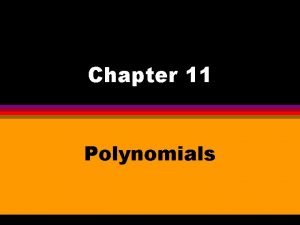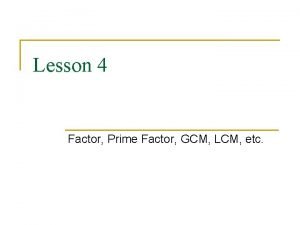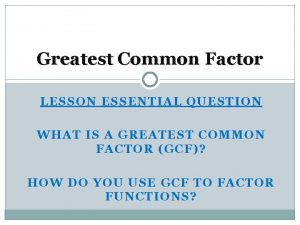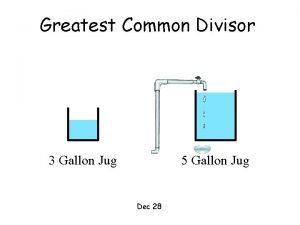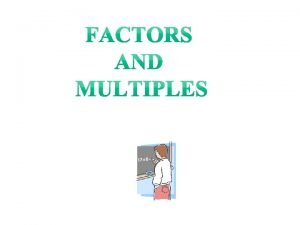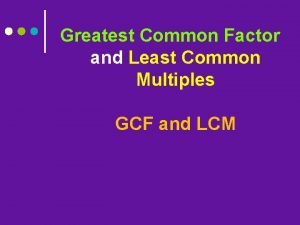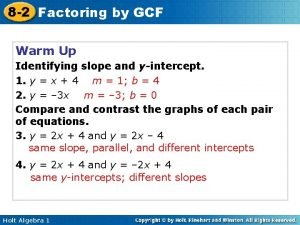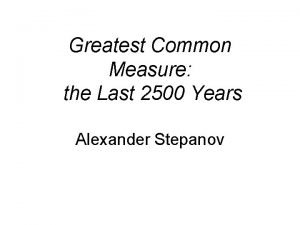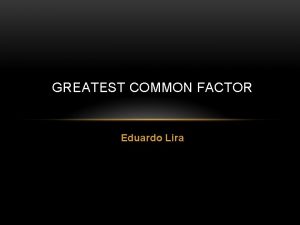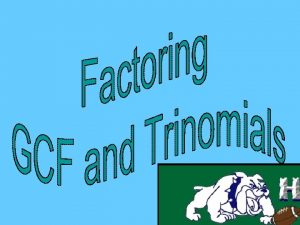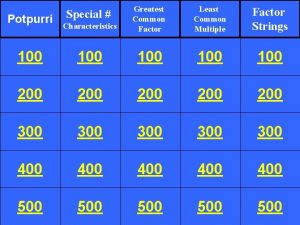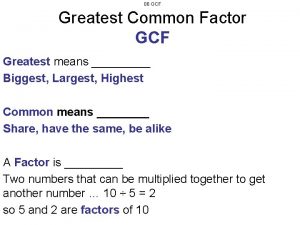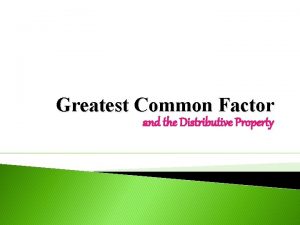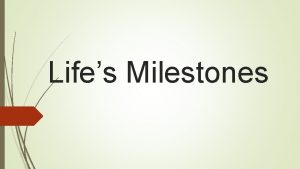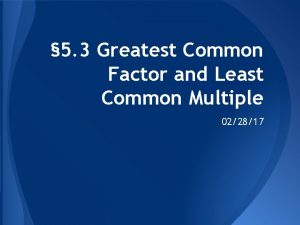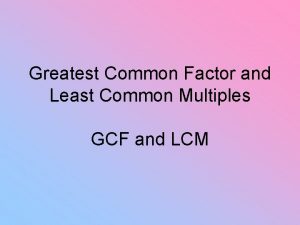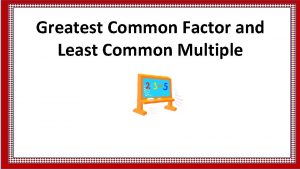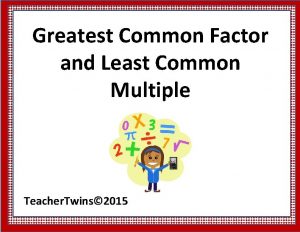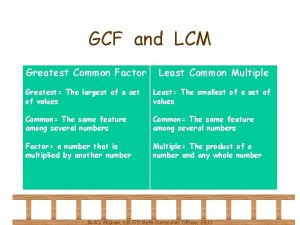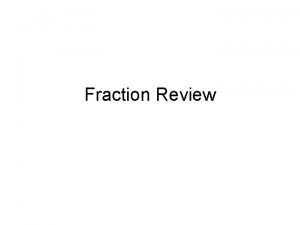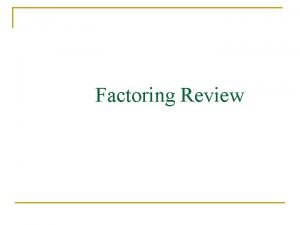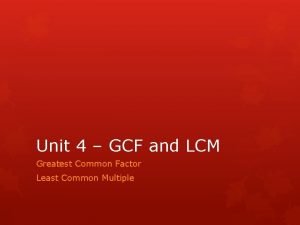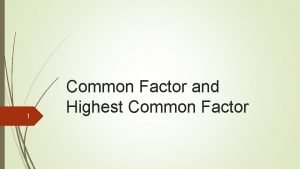Milestones Review Unit 1 Topics Greatest Common Factor
















































- Slides: 48

Milestones Review

Unit 1 • Topics • • Greatest Common Factor Least Common Multiple Distributive Property Adding, Subtracting, Multiplying, and Dividing Decimals • Long Division • Dividing Fractions

Decimals The table shows the average baseball ticket price for three American cities. Location Atlanta New York Los Angeles Average Price $14. 42 $28. 59 $19. 67 http: //www. brainpop. com/math/numbersa ndoperations/decima ls/ How much more expensive is it to buy a ticket in New York than in Atlanta? $14. 17

Operations with Decimals • Dividing: If there is a decimal on the outside of the division sign, you must move it first before you can start dividing. • 575. 82 ÷ 6. 3 • 91. 4 • Multiplying: Multiply like normal and then count the decimal places in your problem and move the decimal to the right in your answer • 7. 85 3. 4 • 26. 69

Greatest Common Factor • You can use the ladder method or the rainbow method. • Remember: factors are the numbers you can multiply together to get a larger number (Ex. 1, 2, 3, 6 are the factors of 6) • What is the GCF of 24 and 16? • 8

Least Common Multiple • List all the multiples of each number until you find the first multiple they have in common • Multiple: think about the multiplication table (Ex. 5: 5, 10, 15, 20…) • What is the LCM of 8 and 10? • 40

Dividing Fractions • Keep, Change, Flip and then just multiply straight across and simplify if necessary • ⅞ ÷ ⅖ • 2 3/16 • ⅔ ÷ ½ • 1 1 /3

Distributive Property • First, find the greatest common factor of the two numbers. • 18 + 24 • GCF = 6 • 6( __ + __ ) • Second, find the number you multiply by the GCF to get the original number. • 6(3 + 4)

Unit 2 • Topics • • Ratio Unit Rate Percent of a Whole Converting Measurements

Unit Price • If three dozen cookies cost $9, what is the unit cost? • A) $0. 25 • B) $0. 50 • C) $3. 00 • D) $4. 00 Money goes on the top of your rate and the total number of cookies will go on the bottom. Then you have to divide.

Converting Fractions, Decimals, and Percentages • Fraction to decimal: Top dog goes in the house (numerator inside the division sign, denominator outside) • Decimal to percent: Move the decimal 2 times to the right • Percent to decimal: Move the decimal 2 times to the left

Ratios • Ratios can be written 3 ways: as a fraction, with a colon, or with words. Order is very important with ratios. • Amy has 5 apples and 10 oranges. What is her ratio of apples to total pieces of fruit? • Max has 3 dogs and 2 cats. What is the ratio of cats to dogs? #1 = 1: 3 #2= 2: 3

Measurements • Metric System: Remember K H D B D C M. The measurements at the base are meter, liter, and gram. • Customary System: Remember the gallon man. • • Convert 25 meters to kilometers Convert 50 deciliters to milliliters How many gallon are in 12 quarts? How many pints are in 8 cups? #1 =. 025 km #2 = 5000 m. L #3 = 3 gallons #4 = 4 cups

Percent of a Whole • Change the percent to a decimal and multiply by the whole number. • What is 30% of 50? • What is 60% of 45? #1 = 15 #2 = 27

Unit 3 • Topics • • Exponents Writing Expressions from word problems Order of Operations Parts of an expression: sum, term, product, factor, quotient, coefficient, constant • Substitution with expressions • Combining like terms • Properties

Exponents • Example: 43 = 4 4 4 = 64 • 62 • 53 • 24

Writing Expressions • Which of the expressions represents the statement, "22 more than a number squared decreased by 12"? • A) 22 + x 2 - 12 • B) 22 - x 2 - 12 • C) 22 - x 2 + 12 • D) x 2 - 22 - 12 Pick out your key words first!

Writing Expressions • Mary puts 5 dollars in her piggy bank per week, and her mom added $20 on her birthday. Mary’s birthday is this week. Write an expression to show much money Mary has saved in an unknown number of weeks. 1. Identify the key words Per = multiply and added = add 2. Choose a variable for the unknown number w= the number of weeks Mary has been saving 3. Determine the constant 20 4. Write the expression 5 w + 20

Order of Operations http: //www. youtube. com/watch? v =OWyx. Wg 2 LTY&edufilter=f. U 9 N 1 e_9 JCp 4 r. Avc 4 Pa. Vk. Q Parentheses Exponents Multiply OR Divide Add OR Subtract Ø 62 – (3 + 27 ÷ 9) • 30 Ø 2(3 + 9) – 10 • 14 Ø 5 + (10 + 3 • 4) – 6 • 21

Substitution • If x = 5 and y = 7 then 3 x + y would equal what? • Remember to place numbers in parentheses when you substitute! 3(5) + 7 = 15 + 7 = 22

Combining Like Terms • You can combine terms that have the same variable to the same exponent. • 3 x + 5 y – x + 7 y • 3 w 2 + 8 – 4 + 4 w #1 = 2 x + 12 y #2 = 3 w 2 + 4 w + 4

Properties • Identity, Associative, Commutative, Distributive • Which property matches each example? • 7 + (3 + 5) = (7 + 3) + 5 • 3+5=5+3 • 5+0=5 • 4(3 + 2) = 12 + 8 #1 = Associative #2 = Commutative #3 = Identity #4 = Distributive

Unit 4 • Topics • Write equations/inequalities from word problems • Solving equations • Solving inequalities

Inequalities • greater than >, less than <, greater than or equal to ≥, less than or equal to ≤ • To solve an inquality, you solve it exactly like an equation (WYDTOSDTTO). • 3 x ≥ 27 • x ≥ 9; any number 9 or greater • To write an inequality from a statement, you must choose the key words and pick which symbol matches the key word • The cost of the shirt will be no more than $10. • s ≤ 10

Solving Equations • Use inverse operations! • What you do to one side, do to the other! • x – 10 = 17 • x = 27 • y/ 8 =9 • y = 72 • 4 c = 24 • c=6

Equations The product of two numbers is 48, and one of the numbers is 12. Find the other number. Which equation can be used to solve this problem? A) 48 x = 12 B) 12 x = 48 C) x/12= 48 D) x/48= 12

Unit 5 • Topics • Area of square, rectangle, triangle, parallelogram, and trapezoid • Volume of rectangular prisms • Nets of 3 D figures • Surface area

Nets • James cut this shape from a piece of paper. He is going to fold the shape along the dotted lines. What solid will James create? • A) octahedron • B) tetrahedron • C) triangular prism • D) triangular pyramid http: //www. brainpop. co m/math/geometryandme asurement/polyhedrons/ preview. weml

Volume How many cubes are inside the rectangular prism? A) 21 cubes B) 28 cubes C)36 cubes D)42 cubes

6 cm. 12 m 4. 8 m ------------------------------- Area 4 cm. Area= 12 cm 2 Area= 57. 6 m 2 http: //www. brainpop. com/math/geometryandmeasurement /areaofpolygons/

Surface Area • What is the surface area of the following shape? Use the formula: SA = 2(ab) + 2(bc) + 2(ac) Choose which sides are you’re a, b, and c first. SA = 324

Unit 6 • Topics • • • Statistical questions Mean, median, mode, range Dot plots Histograms Box and whisker plots (5 Number Summary)

Mean, Median, and Mode • Use the data set to answer the following questions: 6, 5, 14, 9, 7, 12, 17 • What is the median? • What is the mean? • What is the mode? • Median: 9 • Mean: 10 • Mode: No mode

Interpret the Histogram • How many animals travel at a speed between 20 and 40 miles per hour? • How many animals travel above 60 miles per hour? #1 = 15; #2 = 2

Dot Plot What is the median, mode, and range of the data on the dot plot? Median: ¼; Mode: 1/8; Range: 7/8

How to create box and whisker plots • Step 1: Order the numbers from least to greatest Data set: 20, 15, 23, 8, 20, 15, 25, 16, 18 8, 10, 15, 16, 18, 20, 23, 25 • Step 2: Identify your minimum and maximum 5 Number Summary Min: 8 1 st Quartile: Median: 3 rd Quartile: Max: 25

How to create box and whisker plots continued… • Step 3: Find the median 8, 10, 15, 16, 18, 20, 23, 25 5 Number Summary Min: 8 1 st Quartile: Median=17 • Once you find the median, draw a fence in your data set to separate the lower and upper half. Median: 17 3 rd Quartile: Max: 25

How to create box and whisker plots continued… • Step 4: Find the first quartile (Find the median of the lower half) 8, 10, 15, 16, 18, 20, 23, 25 • Step 5: Find the third quartile (Find the median of the upper half) • 8, 10, 15, 16, 18, 20, 23, 25 5 Number Summary Min: 8 1 st Quartile: 15 Median: 17 3 rd Quartile: 20 Max: 25

Draw the box and whisker plot 5 Number Summary Min: 8 1 st Quartile: 15 Median: 17 3 rd Quartile: 20 Max: 25 5 10 15 20 25

Unit 7 • Topics • • • Absolute Value Positive and Negative integers Putting numbers on a number line Ordering rational numbers Plotting points on the coordinate plane

Absolute Value • Absolute Value is a number’s distance from zero. • Distance is always positive! • |5| • |-7| #1 = 5; #2 = 7

Comparing Integers • Compare the following integers by using an inequality symbol • -2 ____ -10 • 5 _____ -3 • -4 _____ 0 • 12 _____ 15 • -26 _____ -27 >, >, <, <, >

Think Fast! • Which point represents -7? • What integer is represented by point D? • Which 2 points represent opposites? A B -10 D E C -5 0 #1 = B; #2 = -1; #3 = C and E 5

More Practice -2 A B C -1 0 1 2 • What are the intervals of this number line? • What values do the points represent? #1 = ¼ ; #2 = A is -1 ½ B is – ¾ C is 2 ¼

Ordering Rational Numbers • Khan Academy: https: //www. khanacademy. org/math/cc-sixth-grade-math/cc-6 thnegative-number-topic/cc-6 th-comparing-negativenumbers/v/ordering-rational-numbers • To put rational numbers in order, you need to plot them on a number line! • Or you can turn your numbers into decimals because they are the easiest to compare. • Put these numbers in order from least to greatest: 0. 5, ¾, -1½, |0. 8| • Correct order: -1½, 0. 5, ¾, |0. 8|

Plot the coordinates on the coordinate plane. (-4 , 5) (-3, -2) (2, 1) (6, -3)

Polygon #1 • (3, 4) • (7, -5) Final Vertex (3, -5) Perimeter: 26 units Area: 36 units 2

Helpful Websites • https: //www. brainpop. com/math/ • Login: Username = lumpkin, password = indians • https: //www. khanacademy. org/math/cc-sixthgrade-math
 Common factors of 36 and 48
Common factors of 36 and 48 Factor out the greatest common factor
Factor out the greatest common factor Factor gcf
Factor gcf Greatest common factor and least common multiple
Greatest common factor and least common multiple Gcf of 34
Gcf of 34 Gcf of 63 and 35
Gcf of 63 and 35 Greatest common factor of 60
Greatest common factor of 60 The gcf of two whole numbers is the
The gcf of two whole numbers is the Factor tree of 78
Factor tree of 78 Lesson 1 factoring using the greatest common factor
Lesson 1 factoring using the greatest common factor What is the greatest common factor of 42 and 84
What is the greatest common factor of 42 and 84 Hcf of 32 and 48
Hcf of 32 and 48 Find the greatest common factor of 24 and 36
Find the greatest common factor of 24 and 36 Gcf of 24 and 60
Gcf of 24 and 60 Greatest common factor of 7 and 9
Greatest common factor of 7 and 9 Greatest common factor of 27 and 36
Greatest common factor of 27 and 36 What is the greatest common factor of 36, 12, and 45
What is the greatest common factor of 36, 12, and 45 What is a greatest common factor in math
What is a greatest common factor in math Greatest common factor with exponents
Greatest common factor with exponents Gcf of 28 and 42
Gcf of 28 and 42 Greatest common factor of monomials
Greatest common factor of monomials All factors of 60
All factors of 60 Factor out completely
Factor out completely Gcf of 36 and 90
Gcf of 36 and 90 Factoring gcf
Factoring gcf Umbrella method
Umbrella method What is the common monomial factor
What is the common monomial factor Common factors of 24 and 30
Common factors of 24 and 30 Greatest common factor of 60
Greatest common factor of 60 Gcf of 8 and 28
Gcf of 8 and 28 Greatest common factor of 7 and 9
Greatest common factor of 7 and 9 Gcf of 14 and 42
Gcf of 14 and 42 Multiple of 5
Multiple of 5 Highest common factor
Highest common factor Lcm 13 and 3
Lcm 13 and 3 Lesson 8-2 factoring by gcf
Lesson 8-2 factoring by gcf Greatest common monomial factor of 5a3+a3b
Greatest common monomial factor of 5a3+a3b Greatest common factor prime factorization
Greatest common factor prime factorization Prime factorization definition
Prime factorization definition What multiplies to 60
What multiplies to 60 4-3 gallon water jug problem
4-3 gallon water jug problem What is the greatest common factor of 36 and 90
What is the greatest common factor of 36 and 90 Multiples of 72
Multiples of 72 Unit 6 review questions
Unit 6 review questions Factoring by gcf
Factoring by gcf Greatest common measure
Greatest common measure 7-1 factors and greatest common factors
7-1 factors and greatest common factors Factors of 8-
Factors of 8- Algebra 2 unit 1 test
Algebra 2 unit 1 test

